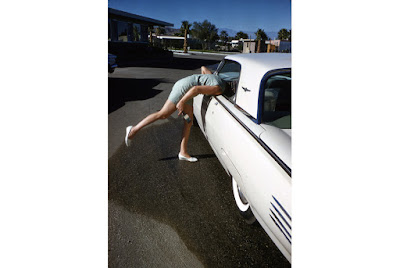Gueorgui Pinkhassov guides the onlooker along the windingly narrow streets of the evocative city of Venice. A place most people have a mental image of: the grand canal with its gondolas, St. Mark's Square, the movie stars trailed closely by the paparazzi; these pictures show us a totally different and unexpected place.
They captures an atmosphere, a game of mirrors, leaves reflected in puddles, the water condensing on glass windows, the sharp shades that fall onto the street below from glaring lamp posts above. Pinkhassov seems to be aimlessly walking through the narrow streets, absorbing the sounds and smells that drift through the air, a discreet observer that translates his impressions in exquisitely poetic pictures.

Met boeken in badkuipen, boten en een oude gondel, en direct gelegen aan het kanaal, vind je waarschijnlijk nergens een originelere boekwinkel. Kan je geen genoeg krijgen van Libreria Aqua Alta? De eigenaar, Luigi Frizzo, verhuurt enkele kamers in zijn B&B aan de overkant van de Calle Longa. Maar Venetië heeft nog veel meer te bieden op ‘boekgebied’!
Bertoni
Zo vind je bijvoorbeeld in de sestiere (wijk) San Marco een van de oudste boekhandels van Venetië: Bertoni. Alles wat maar raakt aan de Venetiaanse cultuur is hier te koop. En een ander pluspunt: Bertoni biedt prachtige kunstboeken aan voor de helft van de prijs. De meeste boeken zijn helaas wel in het Italiaans. Het filiaal aan de Rio terá dei Assassini, vlakbij de Campo San Anzolo, is het prettigste van de twee Bertoni’s. De atmosfeer ademt die van een antieke boekwinkel en het personeel spreekt er Engels.

Marco Polo: alles voor de echte reiziger
In Cannaregio is Marco Polo gevestigd, een boekhandel voor de echte reiziger. Ook deze winkel kent twee filialen, één aan de Salizada San Lio, geheel gewijd aan reisboeken, en één aan de Calle del Teatro Malibran. De boekenkasten barsten bijna uit hun voegen van de reisgidsen over Venetië, maar ook over andere steden, landen en continenten. Marco Polo biedt verder een excellente keuze aan Venetiaanse kookboeken.
Mare di Carta: alles wat je altijd al over de zee wilde weten
Wil je een boek over de zee dan is de kleine, gezellige boekhandel Mare di Carta dé plek om je op te verheugen. Hier vind je werkelijk alles wat met de zee van doen heeft, wat erin leeft, wat erop vaart (van zeeschepen tot gondels), de handel over zee, maar ook cd’s met het gezang van de gondeliers en oude vissersliederen. Heb je een eigen schip, dan vind je hier zeker de regionale zeekaarten die je zoekt. De zaak ligt in het noorden van Santa Croce (Fondamenta dei Tolentini 222), waar de zeelucht de kooplust ongetwijfeld nog een beetje extra aanwakkert. Veel boeken zijn in het Engels.

Studium Bookshop: gespecialiseerd in Engelstalige kinderboeken over Venetie
Bij de ‘Studium Bookshop’, vlakbij de Basiliek San Marco aan de Calle di Canonica 337, kan je Engelstalige boeken over Venetië, Venetiaanse kunst en literatuur krijgen. De winkel is gespecialiseerd in Engelstalige kinderboeken over Venetië, bijvoorbeeld over de spectaculaire ontsnapping van Casanova uit de gevangenis.
Toletta: het adres voor wie Italiaans leest
Bij Toletta, een universiteitsboekwinkel aan de Sacca de la Toletta 1175 in Dorsoduro, vind je een uitgebreid assortiment boeken over architectuur, kunst (inclusief hedendaagse kunst), literatuur en filosofie. Helaas vooral in het Italiaans. Veel boeken worden voor de helft van de prijs aangeboden, dus als je Italiaans leest is dit een heel goed adresje!

Damocle: een boekhandel in pocketformaat
In de miniboekhandel (tevens uitgeverij) Damocle ( Calle Perdon 1311 in de sestiere San Polo) tref je kleine schatten aan. Bijvoorbeeld de boeken van Luigi Pirandello (verfilmd door de gebroeders Taviani) in het Engels, Chinese poëzie (tweetalig), boeken van Spaanse auteurs (ook tweetalig uitgegeven), en alles met veel zorg voor het ambacht van drukken en binden, vaak in samenwerking met lokale en buitenlandse kunstenaars.
Giunti al Punto Libreria Giunti al Punto ligt vlakbij het treinstation van Venetië. In vergelijking met sommige andere boekwinkels zijn hier veel Engelstalige boeken te koop, variërend van boeken over de stad, tot Venetiaanse cultuur-en kunstgeschiedenis en kookboeken.
Old World Books: een ware goudmijn
In het historische hart van het getto van Venetië ligt de boekhandel van John Francis Phillimore: Old World Books. Deze zaak is een ware goudmijn voor zeldzame boeken over Venetië en Italië, variërend van 16de eeuwse edities in kleine oplagen tot de laatste ‘Donna Leon’ (thrillers over de Venetiaanse commissaris Brunetti), soms gesigneerd door de auteur zelf die hier dichtbij woont.
Je weet trouwens nooit wie je bij Old World Books tegen het lijf loopt want de eigenaar is organisator van Casa delle Parole (Huis van Woorden), een literair genootschap dat elke tweede dinsdag van de maand in het theater van Palazzo Grassi een avond organiseert met dichters, filosofen en schrijvers van over de hele wereld, die lezingen houden in hun eigen taal, vertaald naar het Italiaans.

Libreria Emiliana: de oudste boekhandel van Venetie
Van ‘Libreria Emiliana’, vlakbij de Campo Dei Frari , 2941 San Polo, wordt gezegd dat dit de oudste boekhandel van Venetië is. Hun aanbod is in ieder geval ‘oud’. Je vindt hier boeken uit de 17de en 18de eeuw, kaarten, grafiek, en nog veel meer onvoorstelbaar mooie antieke boeken over Venetië. Zeer de moeite waard om een bezoekje aan te brengen.
 Museumboekwinkels en -cafe's
Museumboekwinkels en -cafe's Ook de Venetiaanse musea, onder de noemer Musei Civica di Venezia, beschikken tegenwoordig over moderne ‘bookshops’, uiteraard meertalig, en vooral veel gidsen en catalogi van tentoonstellingen.
Bij het Palazzo Ducale, het Museo Correr, Ca’ Rezzonico, Ca’ Pesaro (en de International Gallery of Modern Art), kan je het ‘bookshoppen’ combineren met een bezoekje aan het museumcafé.
Vanuit het cafe Correr heb je een uniek uitzicht over de Piazza San Marco. Dit museumcafé en het café van de Internationale Gallery of Modern Art zijn ook open voor niet-museumbezoekers. Bij het café van Ca’Pesaro zit je ‘eerste rang’ aan het Canal Grande van Venetië.

































































